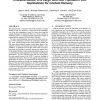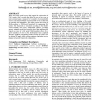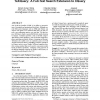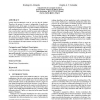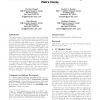WWW
2004
ACM
15 years 8 days ago
2004
ACM
Studying Web graphs is often difficult due to their large size. Recently, several proposals have been published about various techniques that allow to store a Web graph in memory ...
WWW
2004
ACM
15 years 8 days ago
2004
ACM
Recently, active behavior has received attention in the XML field to automatically react to occurred events. Aside from proprietary approaches for enriching XML with active behavi...
WWW
2004
ACM
15 years 8 days ago
2004
ACM
This paper presents a systematic study of the properties of a large number of Web sites hosted by a major ISP. To our knowledge, ours is the first comprehensive study of a large s...
WWW
2004
ACM
15 years 8 days ago
2004
ACM
WWW
2004
ACM
15 years 8 days ago
2004
ACM
One of the key benefits of XML is its ability to represent a mix of structured and unstructured (text) data. Although current XML query languages such as XPath and XQuery can expr...
WWW
2004
ACM
15 years 8 days ago
2004
ACM
Current search technologies work in "one size fits all" fashion. Therefore, the answer to a query is independent of specific user information need. In this paper, we des...
WWW
2004
ACM
15 years 8 days ago
2004
ACM
The Web Ontology Language (OWL) defines three classes of documents: Lite, DL and Full. All RDF/XML documents are OWL Full documents, some OWL Full documents are also OWL DL docume...
WWW
2004
ACM
15 years 8 days ago
2004
ACM
This paper provides an objective evaluation of the performance impacts of binary XML encodings, using a fast stream-based XQuery processor as our representative application. Inste...
WWW
2004
ACM
15 years 8 days ago
2004
ACM
The rapid growth of the web has been noted and tracked extensively. Recent studies have however documented the dual phenomenon: web pages have small half lives, and thus the web e...
WWW
2004
ACM
15 years 8 days ago
2004
ACM
For the manual semantic markup of documents to become widespread, users must be able to express annotations that conform to ontologies (or schemas) that have shared meaning. Howev...

